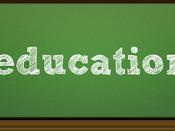Outline
I)Introduction
a)What are wetlands?
b)What is their importance?
II)National Legislation
III) Local Legislation
IV) Education
a)Programs
i)Phase into Learning
ii)Nature on the Way to School
iii)Project WET
iv)Project WILD
V)Motivation
VI)Preservation and Restoration
a)Success and failure
b)Hydrogeomorphic (HGM) approach
VII)What does this all come to?
Education and Motivation Associated with Wetland Preservation
Introduction
Imagine dipping your toes into the warm water off the end of the dock during the summer or marching through a bog on a school field trip to learn about native plants. Have you ever taken a biology course in which you measured nitrates in local lakes or creeks? Were you ever instructed to take a sample of water and soil from a marsh to find indicator species? Have you ever just enjoyed the peacefulness of a calm pond or spent a nice day fishing? Any person may ask what the point here is. The point is all of these situations and instances deal with various components of wetlands and a good majority of people do not even realize what these wetlands provide to them until it is taken away or destroyed.
Many people do not really know what makes up a "wetland." Wetlands are an area of land that is also part of a watershed. U.S. wetlands are categorized by marshes, swamps, bogs, wet meadows, and seasonal basins (U.S. Environmental Protection Agency). These categories are only some of many. They also can consist of dry land. Dry wetlands are a huge concern because many wetland policies and laws do not cover them. Dry wetlands play a big role around the U. S. landscapes as breeding grounds for many waterfowl or function as a maintenance mechanism of regional biodiversity. Many dry wetlands are found in abundance in watersheds and they are usually the first to intercept...


